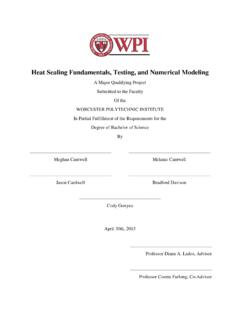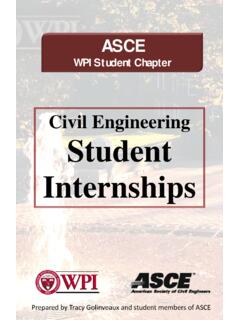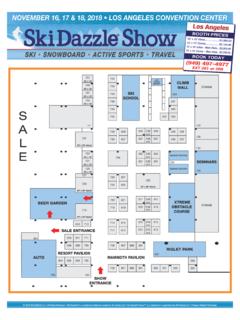Transcription of Telescoping Snowboard Pole - Worcester Polytechnic Institute
1 Telescoping Snowboard pole A Major Qualifying Project Report: Project # JMS 09 01, JMS 09 02 Submitted to the Faculty of the Worcester Polytechnic Institute in partial fulfillment of the requirements for the Degree of Bachelor of Science By _____ David Parry _____ Michael Case _____ Alex Goudas Date: April 30, 2009 Table of Contents Table of Contents .. 2 Table of Figures .. 4 Acknowledgments .. 6 Executive Summary .. 7 Abstract .. 8 Introduction .. 9 Background .. 11 Target Population: .. 12 Materials Selection: .. 12 Current Locking Mechanism Patents: .. 14 Why Our Design is More Suitable For a Snowboarder: .. 20 Areas of Investigation .. 22 Functional Requirements: .. 22 Design Constraints: .. 22 Design Considerations .. 23 Concept 1: Spring Loaded Extension 23 Concept 2: Manual Extension with Automatic Locking System.
2 24 Concept 3: Manual Extension with Internal Automatic Locking System .. 24 Concept 4: Rotating, 360 Internal Locking System .. 25 Concept 5: Twisting coil-pin locking system .. 25 Concept 6: Toothed center column with coil mechanism .. 26 Concept 7: Crank Slider Arms & Locking System .. 29 Concept 8: Crank & Slide with Hex bolt Center Column .. 31 Concept 9: Hex bolt Crank & slide with 33 Concept 10: Addition of hex nuts and springs incorporated .. 35 Concept 11: Bottom Segment .. 36 Final Design .. 37 Preliminary Design Description: .. 38 Making a Solid Model: .. 39 Bushing: .. 42 Spinners: .. 45 Extension Arms: .. 46 Bottom Locking Mechanism Design: .. 47 Adjustable Handle Design: .. 49 pole Storage: .. 51 Stress Analysis: .. 51 Critical Load:.. 51 Bending Strength with Fixed Point: .. 53 Extent of Compression on the Polycarbonate Caps and Rings.
3 54 Parts Machining and Construction .. 56 Description of Cutting and Drilling the Parts Needed:.. 57 Machining of Small Parts: .. 58 Bushing Assembly: .. 58 Bottom Locking/Release Mechanism: .. 60 pole Assembly .. 62 Handle and Handle Bushing: .. 62 Testing: .. 63 Refining: .. 64 Conclusions .. 65 References .. 67 Appendices .. 67 Table of Figures Figure 1 Material Properties of Various Metals .. 13 Figure 2 Physical Properties of Various Materials .. 14 Figure 3 - Patent No. 4,424,987 .. 16 Figure 4 - Patent No. 6,938,927 .. 18 Figure 5 - Patent No. 5,387,048 .. 20 Figure 6 Coil-pin Locking Design .. 26 Figure 7 Toothed Center Column Design .. 27 Figure 8 Full pole View of Toothed Center Column Design .. 28 Figure 9 Side View of Crank Slider Locking Mechanism .. 30 Figure 10 Top View of Crank Slider Locking Mechanism .. 30 Figure 11 Preliminary Hex Bolt Center Column 32 Figure 12 Top View of Preliminary Hex Bolt Center Column Design.
4 32 Figure 13 Multiple Views of Crank-Slider with Washers and Stops Design .. 34 Figure 14 Hex Nut and Spring Additions Side View .. 35 Figure 15 Bottom Segment with Basket Release .. 37 Figure 16 Final Design Sketch of Locking Mechanism .. 38 Figure 17 Exterior View of Locking Mechanism .. 41 Figure 18 Section View of Locking Mechanism .. 41 Figure 19 Isometric View of Bushing .. 43 Figure 20 Bushing View Highlighting Countersunk Bottom 44 Figure 21 Bushing Cross Section .. 45 Figure 22 Spinner Solid Model .. 46 Figure 23 Extension Arms Solid Model .. 47 Figure 24 Bottom Locking/Releasing Mechanism .. 48 Figure 25 - Handle Adjustment Design Extended .. 50 Figure 26 - Handle Adjustment Design Collapsed .. 50 Figure 27 Prototype Bushing Assembly .. 59 Figure 28 Basket Section Extended (Arms Retracted) .. 61 Figure 29 - Basket Section at Rest (Arms Extended).
5 61 Figure 30 Fully Assembled Prototype (Extended) .. 63 Figure 31 Fully Assembled Prototype (Collapsed) .. 63 Acknowledgments We would like to thank Professor John M. Sullivan Jr. for his support, patience and guidance in completing this project. We would also like to thank Professor Mark W. Richman for his assistance in working out some of the technical equations. A special thank you is extended to Neil R. Whitehouse for teaching and guiding us through the long and tedious machining process, this project would not have been possible without his Summary Seeing a need for Telescoping ski poles for snowboarders we designed a pole different than any other previously created Telescoping pole to cater to the needs of a snowboarder. The pole can be safely stored on the board without interfering with the boarder during riding.
6 The pole extends to its locked position and is easily collapsible with winter gloves on. All locking and unlocking mechanisms are located within the poles themselves with no exterior holes. This ensures no debris enters the pole , which can cause complications. The pole also features an adjustable handle which can cater a range of riders with a single pole , and also extends the lifetime use of the pole . It can be used anytime by the rider whether to traverse across a flat or even propel them up a small incline. Many features of this novel pole design have not been successfully implemented in any previous Telescoping ski A Telescoping support pole was developed as a new snowboarding accessory. This novel device utilizes completely internal locking and releasing mechanisms to avoid the introduction of foreign elements such as dirt and water to the system.
7 Each pole segment is free to rotate, preventing torque damage on the assembly. The pole addresses multiple problems that snowboarders may encounter such as free standing support and assistance with traversing across flat or inclined areas. It can be collapsed and extended without removal of winter gloves. This accessory can be safely and easily stored on the person and features an adjustable handle to cater to a wider range of riders. Introduction The goal of our MQP was to design and develop a Telescoping Snowboard pole to assist snowboarders. The pole can be used to help balance the rider while standing, as well as propel themselves along a flat plane or moderate slope. It is quite common for a snowboarder to come to a flat or uphill gradient where they are required to detach one of their bindings in order to propel themselves forward with their free foot.
8 Detaching a binding can be an annoyance since it takes time, and often results in snow getting stuck to the bottom of the boot. It is also somewhat difficult to propel them forward using one foot. Another cause for concern is when a snowboarder is stationary and is standing on their board. It is much more difficult to remain standing on a Snowboard than it is on skis, and the snowboarder may need to sit down on the snow to remain stationary. By using a ski pole , a snowboarder would be able to remain stationary while standing, and be able to propel themselves along a flat or slight slope. It is inconvenient and possibly dangerous for a snowboarder to carry a standard ski pole while descending a mountain. However, by making a ski pole collapsible to a smaller size, a snowboarder can safely store a pole on the inside of their lower leg, and use it when they need it.
9 Our project was to develop a pole that can solve these typical problems snowboarders face, without having to carry a standard full length pole . Telescoping poles are frequently used in various applications such as hiking, umbrellas and ladders. However, their designs would not be able to meet our functional requirements. These pole designs would not be able to withstand the forces applied to it, the environment conditions it would be exposed to, or be able to collapse to our desired length. Our design is such that the pole is able to be collapsed enough for the rider to safely store it on their person. It also needed to make the pole as resistant to winter weather conditions as possible. Since the pole would be exposed to a cold and wet environment, it was decided to develop a pole with as little external mechanisms as possible. The pole would need to be able to sustain varying loads during different types of use as well.
10 Different body sizes and weights were taken into account to decide on a target population. We realized that we would need to design a pole as similar to a normal ski pole possible to provide proper assistance to snowboarders. This meant it would have to be as similar in size, weight, durability, and functionality. The pole would have same capabilities as a standard ski pole , but would enable the snowboarder to safely store the pole when they aren t using it. There are other Telescoping poles available for other activities, but none of them are able to collapse far enough to be stored while riding, or to meet our other functional requirements. Since there is no product current available to deal with the problems snowboarders face, our project was developed in order to solve some of these issues. Background Currently in the snowboarding market there are no devices to aid riders in the instances where they encounter flat or inclined slopes down trails.



















